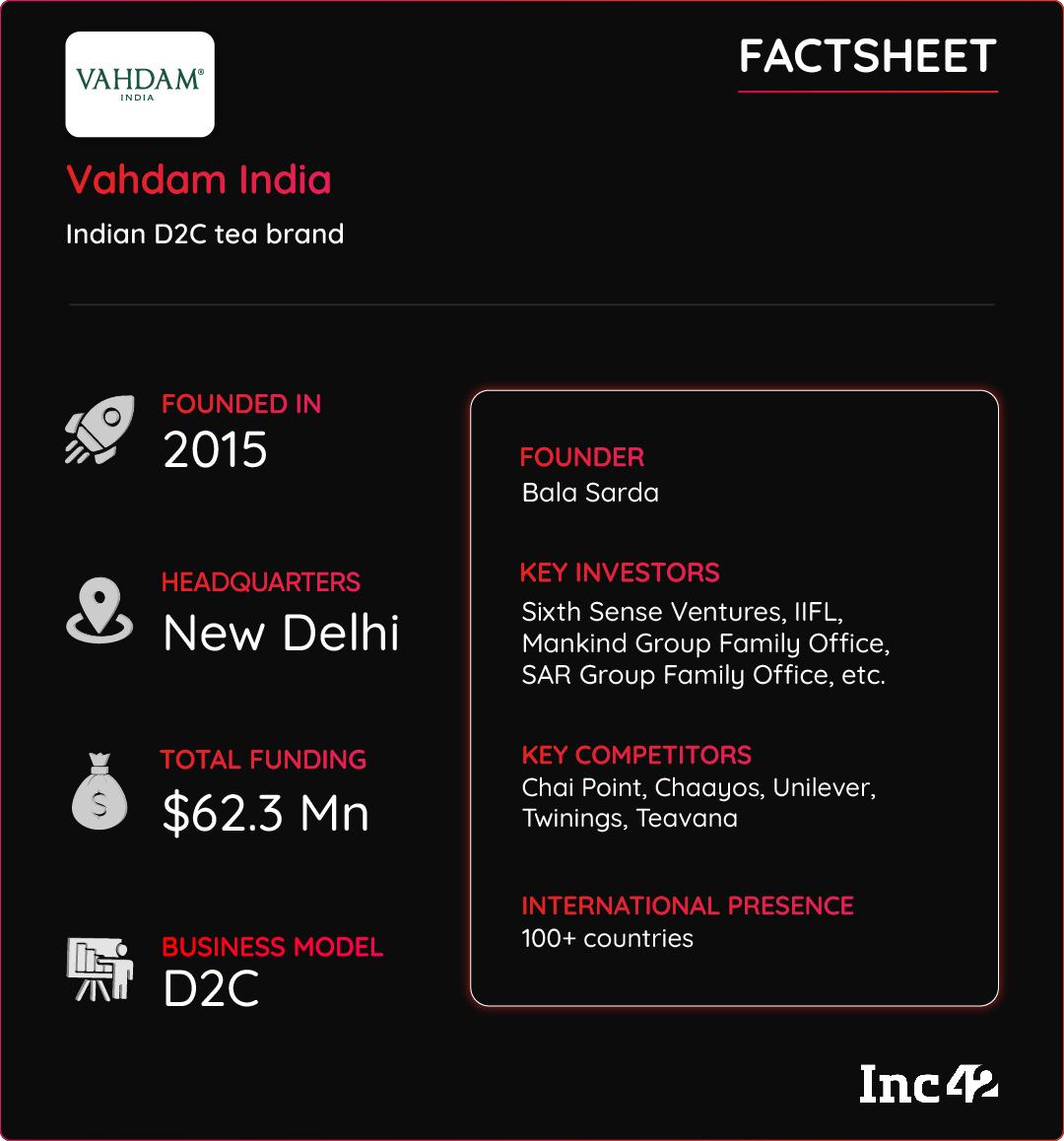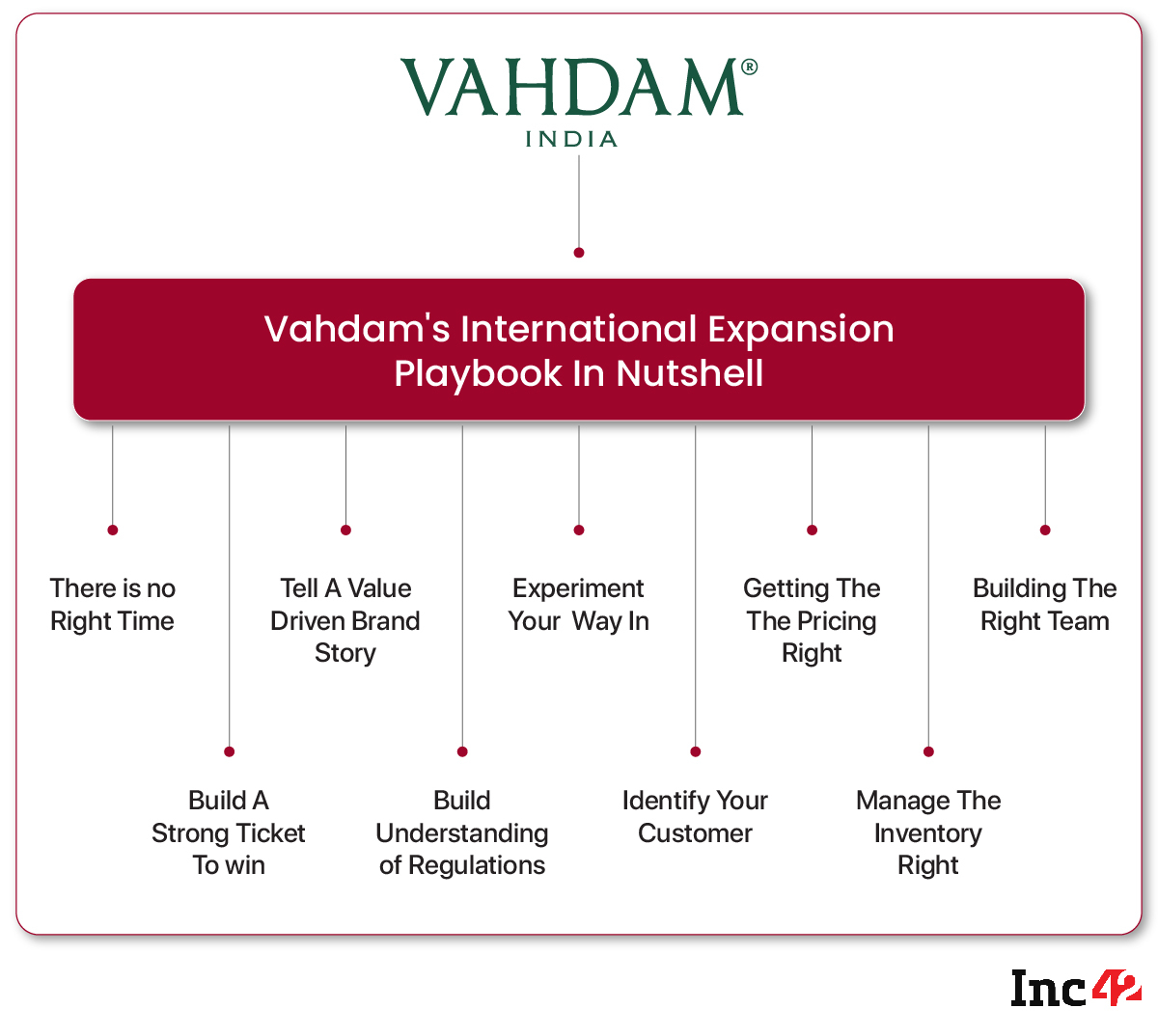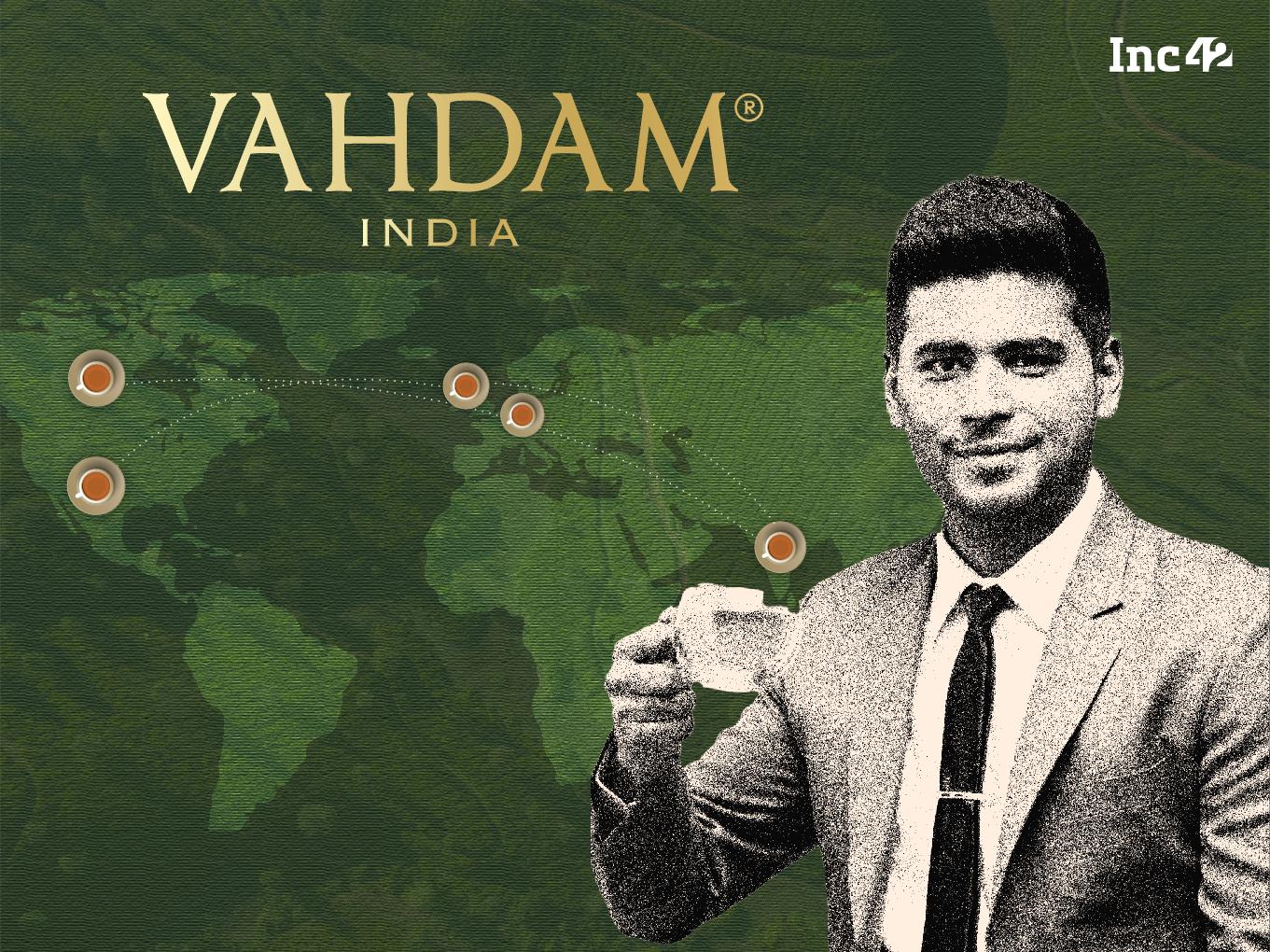Vahdam India, set up in 2015, is credited with taking ‘Made in India’ tea global, and the D2C brand competes now with other international brands
Sharing the learning from Vahdam’s experience, Vahdam CEO Bala Sarda said that there is nothing like a right time for a D2C brand to go global
Speaking at Inc42’s ‘The D2C Summit 3.0’, Sarda advised brands to put efforts in understanding their customers and give 5X more importance to inventory management for global expansion
Despite India being the second largest producer of tea after China, for a long time foreign brands had a significantly higher market share in the global market compared to the Indian tea brands. When Bala Sarda, a fourth-generation entrepreneur from a family which has been in the tea business for 85 years, realised this, he decided to change the status quo.
Sarda set up D2C tea brand Vahdam India in 2015, and within a short span of 7 years, the brand is credited with taking ‘Made in India’ tea global. The Indian tea brand now competes with global brands such as Starbucks’ subsidiary Teavana and Twinings Tea in international stores.
Available in 100+ countries, the brand is endorsed by the likes of Oprah Winfrey, Ellen Degeneres and Mariah Carey. This year, Vahdam also became the first Indian wellness brand to be a part of the Oscars goodie bag, with its tea boxes finding a place in the bag.
The startup turned profitable in FY21 with net revenue of over INR 160 Cr. Vahdam was valued at INR 700 Cr post its last fundraise in 2021.

Sarda is now aiming to take a significant chunk of India’s rising D2C opportunity, which is projected to be worth $302 Bn by 2030.
Meanwhile, several Indian D2C brands across categories such as Mamaerath, Moms Co, Heads Up For Tails, Bewakoof, and Bombay Shirt Company are eyeing global expansion and have taken the first step towards establishing their presence in the international markets.
However, is there a right time for a D2C brand to go global? What are the key challenges a brand may have to face in international markets? What factors do D2C brands need to consider for a successful journey in different markets? At Inc42’s ‘The D2C Summit 3.0’, Sarda shared his advice for the Indian D2C brands to go global based on his experience with taking Vahdam global. Here are the key takeaways:

There is No Right Time
Sarda believes there is nothing like a right time to go global. Citing the progress in infrastructure, he said that this is the most incredible time for brands to expand globally. If a brand has the right differentiation factor and its founders believe in it, then it is perfectly alright to consider taking such a step, he said.
Build A Strong Ticket To Win
The need for a strong “ticket” or a strong factor to win in the global markets cannot be undermined. That factor can be a brand’s product, its distribution, or some innovation in its value chain. Global expansion poses various challenges like a sharp increase in cost, different market-related issues, and more. Hence, the D2C brands need a strong and right reason to address the challenges to expand successfully, the CEO said.
Tell A Value-Driven Brand Story
For Vahdam, the fundamental premise was to launch a brand which was proudly Indian and not just another tea brand. However, building trust in a foreign land for an Indian brand was a tough nut to crack. For this, Vahdam focused on consistency, value addition to the supply chain, and making the consumers feel that they were contributing to a noble cause by consuming the products.
Vahdam decided to make the tea farmers a part of its success story. Under its ‘Teach Me’ program, the brand allocated 1% of its revenue towards the education of children of its partner tea growers. Today 12,000 children are part of this program. It is also a climate-neutral and plastic-neutral certified brand.
“My personal background, my personal story, everything I’m telling you today, every customer of Vahdam gets that through a letter in every pack of Vahdam India we ship globally. And we do billions of units every year now. So right from this story to working over several of these initiatives is fundamental and central to what we do,” said Vahdam founder and CEO Sarda.
Understanding The Regulations
It is very important for a brand to comply with government regulations for success in the global market. However, government regulations vary from one country to another. Besides, there are multiple regulatory bodies involved in some of the segments like food and beverage and personal care. Being a first mover, this was one of the key challenges for Vahdam.
However, the ecosystem has evolved a lot and is very different now. With companies like Amazon and Shopify coming in, and improvements in the overall logistics, payments, banking and the digital infrastructure, things have become a little easier compared to a few years ago, Sarda said.
Digitisation has simplified a lot of things and all the documents are available on government websites now. From ingredients to registration to partnering with delivery partners, everything can be found online now. “All you need to do as a founder is to be thorough in terms of homework and ensure that you’re aware about what’s available at your disposal and use it wherever it stands to,” Sarda added.
Experiment Your Way In
Sarda said that D2C brands aspiring to go global need to experiment a lot to find the perfect partners as per their needs. For instance, while selecting a logistics partner, a brand can either spend months to research everything or do a very small shipment and note down everything from cost of credit to time it took for shipment, and reverse engineer everything.
Companies like Stripe and Amazon PoS have made it easy to set up an entity in the US or Europe. Amazon’s global marketplace platforms, which are operational in 17 countries in the US, Europe, Saudi Arabia, Mexico, Australia, Singapore, among others, allow a D2C brand to start selling immediately at approximately 15% of monthly revenue, he said.
“All these markets could potentially be very big and come with their own set of challenges after a certain scale. So experiment a lot. That’s the right way to approach this,” Sarda added.
Understand Your Customer
Sarda believes that talking to customers is the key to establishing trust and brand value, be it in India or abroad. He said that it is essential for brands to get the product right. For this, they can do Reddit or Facebook surveys before launch, talk to people on different social media groups where the category products are being sold, sell on Amazon marketplace to get initial feedback, or hire a market research company if they have access to initial capital.
“Once the product is launched, the best way is to go B2C with your own website. This way, the feedback loop is extremely efficient,” he advised.
Managing The Inventory
While it is well understood that inventory management is very important while expanding the footprint to international markets, Sarda believes that planning inventory should get 5X more importance while expanding.
Although there is not much difference in global inventory management compared to what’s done in India, lead times are higher for the former. Supply chain design and working capital management also makes a difference in global inventory management, he said.
Since brands cannot change the transit time when processing shipment via sea routes, they must ensure that raw material buying is extremely efficient if freshness is crucial to their products.
Giving an example, Sarda said that if a brand sends shipments from a warehouse in Madhya Pradesh to Gujarat, it will probably take three-four days to deliver. However, if it is delivering to New York port or to a warehouse in Indiana or a bureau centrally located in some European country, the lead time will obviously go up to anywhere between 45 days-90 days.
“Identify the fixed and variable parts of your supply chain. Try to minimise the number of days it takes in each of them and approach your global inventory piece,” said Sarda.
Getting The Pricing Right
There are three methods for pricing the products correctly. First is the top-down approach. Explaining this, Sarda said that If the competition is selling a product at $10, a brand with a differentiated product can potentially add a 20% -30% upward premium and sell it at $13. Next comes the bottom-down approach, which includes identifying the cost to put a differentiated product on the store shelf and the margin structure involved.
He also cautioned that there will be a difference in margins when it comes to India and international markets. Hence, if a D2C brand is not sure about the pricing, it can begin with a mix of both the approaches to find the balance and then find its way ahead using data points.
“(There is) an MRP sort of regulation in some of these markets, so you can do a lot of A/B testing to discover the right price in these markets,” said Sarda.
“I think with these three things, you will be able to identify the price point and then just scale that up at that price,” he added.
Building The Right Team
It is important to build the right team for global expansion for D2C brands. To start with, the brands can hire two people in foreign nations in-house and then go hybrid and add a few people from India. They can also hire employees locally and then have a set of freelancers, Sarda said.
In fact, building the culture in foreign locations could be a challenge. “You’re in a different time zone… the DNA you have in your headquarters is obviously not the same…so I think that is a challenge,” said Sarda. “But having a hybrid setup and communicating with them the vision, getting them to come to India a couple of times to see what you’re doing here…I think that in my opinion is the best way to sort of tackle that, and that’s how any MNC has done in the initial days.”
You can view the complete address of the Vahdam CEO at ‘The D2C Summit 3.0’ here. The number of D2C brands in the country is increasing at a rapid rate. However, these brands continue to face challenges such as high competition from legacy players and marketplaces, difficulty in managing logistics, low customer retention and loyalty, and high customer acquisition cost (CAC). Hence, Sarda’s learning from his experience can prove to be extremely crucial for emerging and aspiring D2C brands aiming to go big and global.
(With inputs from Meha Agarwal)
































 Ad-lite browsing experience
Ad-lite browsing experience